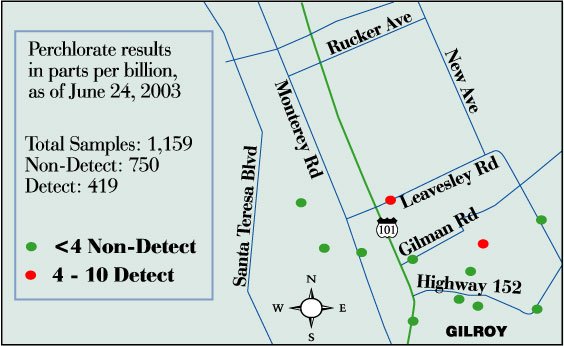GILROY
– A private well off Holsclaw Road south of Gilman Road in
Gilroy has tested positive for perchlorate contamination, leading
water officials to believe the poisonous groundwater plume that has
already tainted 419 wells between Morgan Hill and north Gilroy may
be trickling further south.
GILROY – A private well off Holsclaw Road south of Gilman Road in Gilroy has tested positive for perchlorate contamination, leading water officials to believe the poisonous groundwater plume that has already tainted 419 wells between Morgan Hill and north Gilroy may be trickling further south.
The well owner, whose identity is being kept confidential by Santa Clara Valley Water District, ran a test in May that revealed a 4.7 parts per billion contamination level, less than 1 part per billion above the state’s “action level” which triggers warning notices.
The information was reported to the water district earlier this week, spokesperson Mike DiMarco said. It is the southernmost detection of the chemical since testing began in February. A well at Leavesley Road just east of U.S. 101 tested positive at 4 to 10 parts per billion.
“For right now I’d really consider this part of the plume,” said George Cook, an engineering geologist for the water district. “It’s following the general trend of the plume and Olin Corporation is using this information for its new (well) sampling program.”
Cook said Olin’s testing program will likely expand further south now that a detection below Leavesley has occurred.
Olin is the former Morgan Hill flare manufacturer that contaminated the groundwater table with perchlorate. It is responsible for testing area wells and devising a clean water program for impacted water users.
The old Olin factory is at Tennant and Railroad avenues in Morgan Hill. The company is only testing wells south of the closed factory site for the jet fuel and flare ingredient.
Gilroy water officials do not believe the new detection will impact city wells, even though two city wells exist near Holsclaw and Gilman roads. All eight city wells have been tested monthly since February. To date none has shown perchlorate contamination.
“The more wells that pop up, though, sure isn’t a good thing,” said Dan Aldridge, water operations supervisor for Gilroy. “We’ll continue to monitor this monthly.”
It is possible the new detection spot is independent of the plume.
“There are a lot of sources of perchlorate and we don’t know all the former uses of the land out there,” DiMarco said.
The new detection spot is east of Llagas Creek, near the Syngenta property. Syngenta is a worldwide agribusiness company and seeds producer. It is unknown if the contaminated well is at the Syngenta site since officials from the local plant and at headquarters did not return phone calls before deadline.
Perchlorate is used in the manufacture of jet fuel, flares and fertilizer. Its health risk is still unclear and state and federal testing is under way. At some exposure levels, perchlorate is known to cause thyroid problems and some tumors in humans. What is not known is the levels at which exposure becomes a danger.
The “action level” for perchlorate was lowered in 2002 by the state from 18 ppb to 4 ppb. Wells in Morgan Hill, San Martin and Gilroy have shown contamination levels from 4 ppb to 100 ppb.













